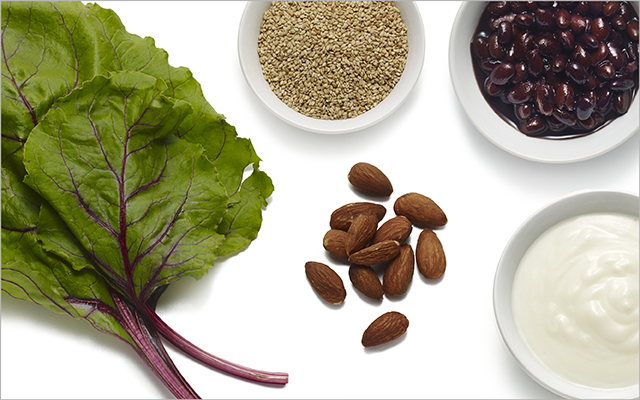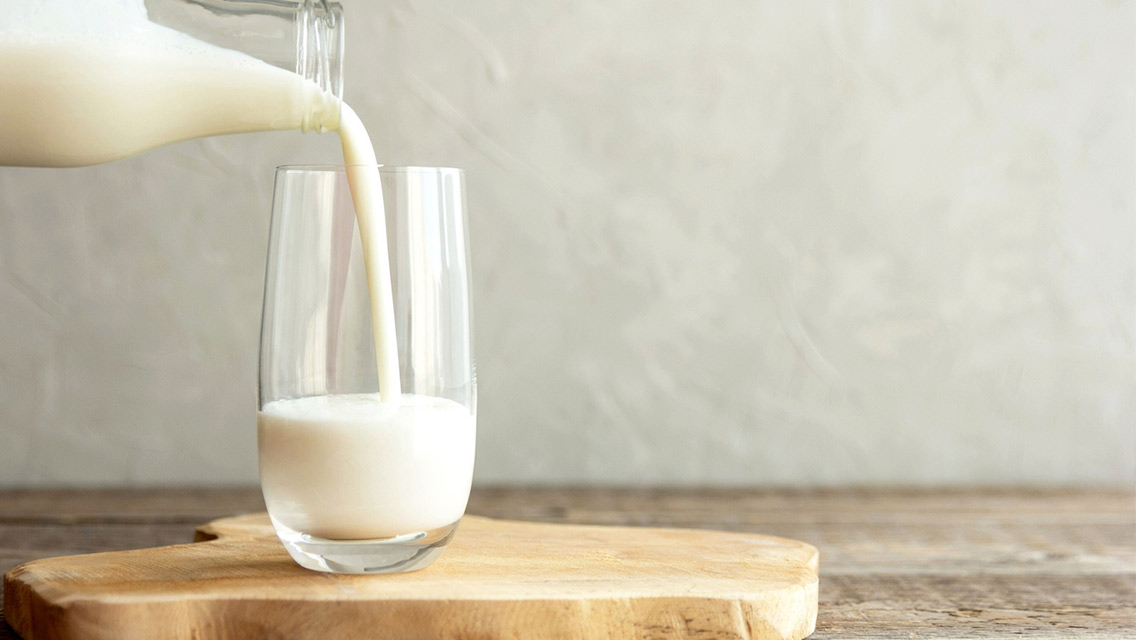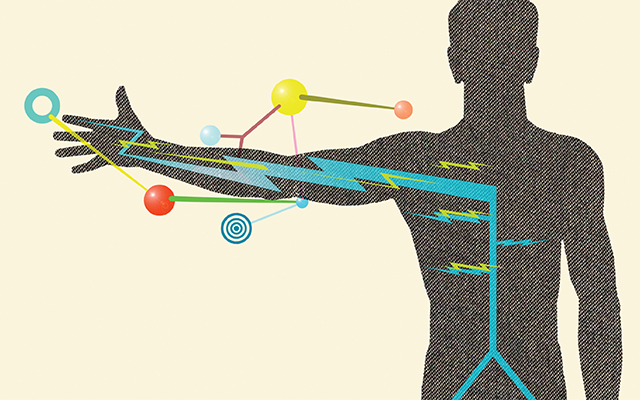If you count on dairy for bone-supporting calcium, chalk it up to compelling advertising. Remember the long-running “Got Milk?” campaign and the “Milk. It does a body good.” commercials? Thanks to more than 30 years of industry-funded marketing efforts like these, we’ve repeatedly heard the message that dairy is the best source for dietary calcium.
But that’s not necessarily the case.
“Americans have been fed a lot of misinformation about dairy products, including milk,” says Mark Hyman, MD, director of the Cleveland Clinic Center for Functional Medicine and author of Food: What the Heck Should I Eat? “There is no evidence that cow’s milk builds better bones.”
“There is no evidence that cow’s milk builds better bones.”
Indeed, various analyses, including the seminal Harvard Nurses’ Health Study, show no correlation between increased dairy consumption and lowered risk of hip or arm fractures due to osteoporosis, a disease characterized by loss of bone tissue.
So, despite heeding recommendations to get plenty of dairy, many people are still coming up short on calcium — and may not even realize it. Some 54 million Americans suffer from low bone density or osteoporosis, according to the National Osteoporosis Foundation. Roughly one in two women and up to one in four men over the age of 50 will break a bone as a result.
While there are many risk factors for osteoporosis (and its precursor, osteopenia), long-term calcium insufficiency is among the most significant.
Calcium Does a Body Good
Calcium is the most abundant mineral in the body. In addition to building bone, it supports a variety of metabolic functions — including blood clotting, vascular contraction and vasodilation, muscle contraction (including heart contraction), and nerve transmission. “Pretty much every cell depends on it,” explains Hyman.
Yet, only a small percentage of the body’s calcium is needed for these biochemical operations. More than 99 percent is stored in the skeleton (including teeth), where it strengthens the collagen-based framework of bone.
Bone is a living structure that continuously remakes itself: New bone tissue is formed from calcium and other minerals, and old bone tissue is resorbed, sending calcium back into the bloodstream. When overall calcium levels are low, the body taps the calcium stores in bone to maintain the right amount in the blood to support the necessary biochemical functions.
“Humans run on a teeter-totter system,” explains functional-medicine physician Gregory Plotnikoff, MD. “The body is constantly working to keep our systems stable — in homeostasis — despite changes in the environment.”
This can come at a price. Drawing on calcium stores to compensate for low circulating calcium over a long period endangers the body’s structure, leading to bone loss, fractures, osteopenia, and osteoporosis.
The good news is that a well-rounded diet rich in whole foods — including bok choy and kale, as well as beans, nuts, and seeds, and bone-in salmon and sardines — can provide most if not all of the calcium we need. Read on to learn more about this valuable nutrient.
Healthy Food Sources
For calcium absorption and retention, whole foods are your best bet. Integrative nutritionist Amanda Archibald, RDN, founder of The Genomic Kitchen, recommends a diverse selection of calcium-rich foods that also deliver nutrients, including vitamin D, vitamin K2, and magnesium — all of which support calcium bioavailability.
“Bone is a matrix of nutrients, so we need to eat a wide variety of healthy foods,” she says. “No single food can do it all. That’s not how the body operates.”
Archibald recommends dairy only in cultured form, such as unsweetened yogurt, kefir, or aged cheeses. “Don’t make dairy your go-to for calcium,” she says. “Make it a side conversation, not the focus.” (For more on why dairy can be problematic, see “The Trouble With Dairy” below.)
The Food and Nutrition Board of the Institute of Medicine, National Academy of Sciences recommends a daily calcium intake of 1,000 mg for women between 19 and 50 years old, and 1,200 mg after that. Men are advised to consume 1,000 mg of calcium daily until age 70, and 1,200 mg afterward. (These values, some skeptics note, are influenced by the dairy industry.)
| Serving Size | Calcium/Serving | |
| Sardines (with bones) | 3 3/4oz. | 351 mg |
| Yogurt (plain, whole milk) | 1 cup | 296 mg |
| Amaranth (cooked grain) | 1 cup | 276 mg |
| Turnip greens (measured raw) | 2 cups | 209 mg |
| Blackstrap molasses | 1 tbs. | 200 mg |
| Sockeye salmon (canned, with bones) | 3 oz. | 168 mg |
| Collard greens (measured raw) | 2 cups | 167 mg |
| White beans (cooked) | 1 cup | 161 mG |
| Bok choy (measured raw) | 2 cups | 147 mg (serving size) |
| Mustard greens (measured raw) | 2 cups | 129 mg |
| Almonds (dry roasted) | 1/3 cup | 122 mg |
| Figs (dried) | 1/2 cup | 121 mg |
| Kale (measured raw) | 2 cups | 107 mg |
| Tempeh | 1/2 cup | 92 mg |
| Beet greens (measured raw) | 2 cups | 89 mg |
| Sesame Seeds | 1 tbs. | 88 mg |
| Chickpeas (cooked) | 1 cup | 80 mg |
| Arugula (measured raw) | 2 cups | 64 mg |
| Black beans (cooked) | 1 cup | 46 mg |
| Broccoli (measured raw) | 1 cup | 41 mg |
Download Sources of Calcium image.
Make the Most of Your Calcium
Getting enough calcium is only part of the equation: Making sure that you keep the calcium you take in, and that your body can use it, is important, too.
“You can take the recommended daily allowance of calcium, but if you don’t maximize absorption and minimize loss, it won’t matter,” says Mark Hyman, MD. “It’s the net effect that counts.” Keep these strategies in mind:
Optimize!
Vitamin D. “Vitamin D is the most important nutrient in our diet in terms of bone health,” says Hyman. “It works synergistically with calcium to improve absorption.”
Vitamin K2. This vitamin directs calcium to where it’s needed most. “It’s a kind of glue that helps your body build bone,” says Amanda Archibald, RDN. A 2001 study in the journal Nutrition found that Japanese women who ate foods heavy in K2, such as fermented soybeans, had a reduced risk of hip fractures. Other K2-rich fare includes egg yolk, chicken (including chicken liver), and grassfed butter or ghee.
Magnesium. Most of us have an inadequate supply of this mineral, says Deborah Wiancek, ND, author of The Natural Healing Companion. Calcium and magnesium work together to relax muscles and move fluids through cells for optimal bone health. (Learn more at “Magnesium: Your Body’s Spark Plug.”)
Minimize!
Calcium-depleting foods. Some aspects of the Western diet may deplete calcium stores and contribute to bone loss. Excessive sodium is associated with urinary calcium loss. Experts debate optimal sodium levels (see “Is Salt Bad for You — Or Not?“), but they agree that nearly 70 percent of Americans’ salt intake comes in the form of processed foods.
Hyman points to coffee and cola, which have been shown to leach calcium, perhaps due to their caffeine content (though notably, black tea does not have this effect) or the phosphoric acid in cola.
And even healthy whole foods can negatively affect calcium availability. Phytates in beans and legumes can decrease calcium absorption (soaking can reduce this), as can oxalates in spinach and beet greens (a good reason to mix things up now and then).
Medications. Common medications, including proton pump inhibitors (PPIs), glucocorticoids, and anticonvulsants, have been shown to diminish bone density, because they affect how calcium is absorbed and metabolized.
The Trouble With Dairy
When the federal government published its Dietary Goals for the United States in 1977, milk wasn’t included in its recommendations. The dairy industry subsequently pressured Congress to create a program in which producers financed marketing campaigns to promote milk and other dairy products.
The U.S. Department of Agriculture (USDA) approved these campaigns — including the “Got Milk?” ads — and promoted dairy-heavy menus in restaurants and dairy requirements for school lunches. Today, the USDA recommends 2 to 3 cups of dairy for children daily, and 3 cups for adults.
Dairy’s institutionalized promotion has caused problems for people who have an adverse reaction to these products, including the 25 percent of Americans who are lactose intolerant (meaning they lack the enzyme needed to digest milk’s lactose). This includes approximately 70 percent of African Americans, 90 percent of Asian Americans, 53 percent of Mexican Americans, and 74 percent of Native Americans.
And dairy often contains elements that research shows can have detrimental effects on our health, even if we don’t have allergies, sensitivities, or intolerances:
Estrogen and progesterone: Cow’s milk contains high levels of these hormones. Research associates milk consumption with increased incidence of hormone-dependent cancers, including breast, ovarian, uterine, testicular, and prostate.
Insulin-like growth factor-1: This hormone found in dairy products promotes cell growth and division in normal cells as well as cancer cells, further increasing potential risk.
Antibiotics: Used on cows and other livestock to prevent infection and promote growth, subtherapeutic levels of antibiotics can result in antibiotic resistance in people.
“All the problems with milk make you wonder if we’re supposed to be drinking cow’s milk as adults,” says naturopath Deborah Wiancek, ND. (For more on the debate surrounding milk and dairy products, see “Do You Need Milk?“)
Deficiency Risk Factors
If you’re acutely deficient in calcium, the body has ways to let you know: Abnormal heart rhythms, blood-clotting problems, muscle spasms or cramps, numbness and tingling in the fingers, and high blood pressure can be signs. But bone loss often happens so gradually that you may not realize you’re low on the mineral until you have a bone-density test or x-ray after a fall.
Aging is a general risk factor: Older adults tend to consume less dietary calcium (and less food overall), and they’re prone to getting less vitamin D — which is necessary for calcium absorption — from either diet or sunlight.
Women often experience a calcium deficiency postmenopause, when declining estrogen production increases bone resorption and decreases calcium absorption. Declining testosterone in men is associated with decreased bone density as well. And people who don’t or can’t consume dairy — including vegans and those who are lactose intolerant or casein sensitive — can find themselves calcium deficient if they don’t add other sources of the mineral to their diets.
Know Your Levels
Actual calcium levels are difficult to measure. Since vitamin D is key to healthy calcium levels (it helps make the hormone calcitriol, which improves calcium and phosphorus absorption), doctors often rely on vitamin-D testing to identify calcium insufficiencies.
“Monitoring your vitamin-D levels is the single most important thing you can do if you are worried about bone health,” says Mark Hyman, MD, who notes that most people will need to supplement with this vitamin. “If you don’t get enough vitamin D, you won’t absorb enough calcium to support important functions. You’ll lose bone mass, and your bones become weak and porous, putting you at risk for osteoporosis.” (Learn more about vitamin D, including ideal levels and best sources, at “Vitamin D: What You Need to Know.“)
Supplement Wisely
Some research has concluded that calcium supplements don’t help — and may even be harmful. But certain studies may be flawed if calcium was taken without companion nutrients such as vitamins D or K2, says Gregory Plotnikoff, MD. And if participants were vitamin-D deficient, calcium absorption would have been reduced.
Our experts offer the following advice, noting that it’s wise to consult with a trusted practitioner.
- Think holistically. Naturopath Deborah Wiancek, ND, suggests consuming five to 12 servings of calcium-rich vegetables, seafood, nuts, and grains each day, in addition to 1,000 mg supplementation of calcium citrate or calcium glycinate, both of which are easily absorbed. (Note: The body can’t absorb more than 500 mg at a time, so take half in the morning and half in the evening.)
- Think preventively. Because postmenopausal women don’t produce enough estrogen to support bone health, supplementation is key. Be proactive: Wiancek suggests that women supplement with calcium starting at age 20.
- Think synergistically. Mark Hyman, MD, recommends taking 1,000 to 2,000 IUs of vitamin D3 daily — not the synthetic (and commonly prescribed) D2, which is less bioavailable. If testing reveals a vitamin-D deficiency (less than 50 ng/dL), you’ll need more. He also advises taking 180 to 200 mcg of vitamin K2 and 100 to 200 mg of magnesium twice daily.
- Think genetically. “Once you know your individual genetic blueprint, you can put together a food and dietary supplementation plan that optimizes the nutrients you need most,” says Amanda Archibald, RDN, who recommends gene-sequencing products, such as Genoma, smartDNA, and NutritionGenome. “All of these companies require clinicians to interpret the results. Otherwise, you are left wondering what to do with what you’ve learned.”
This originally appeared as “Got Calcium?” in the October 2018 issue of Experience Life.




This Post Has 0 Comments